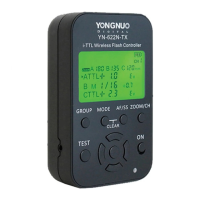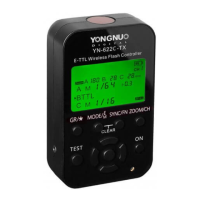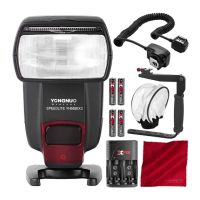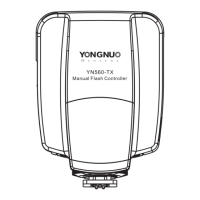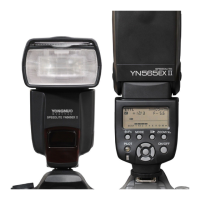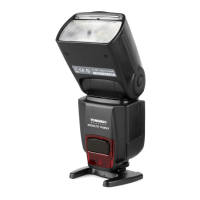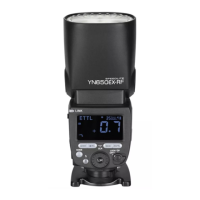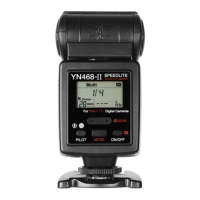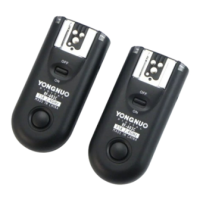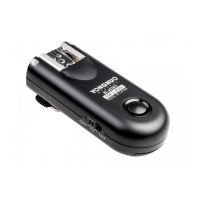Do you have a question about the Yongnuo YN-622C and is the answer not in the manual?
Important warnings and guidelines for safe product usage and handling.
Details the YN-622C E-TTL wireless flash trigger's capabilities and design.
Lists all supported modes, sync options, and features like TTL, HSS, and FEB.
Identifies compatible camera types (A, B, C) and ETTL flash models.
Details indicators, buttons, ports, and physical parts of the transceiver.
Instructions on how to insert AA batteries into the transceiver.
Guide on attaching the transceiver to the camera's hot shoe.
Steps for attaching a flash to the transceiver when used as a receiver.
How to turn the transceiver on and off using the power switch.
Steps to select and set the wireless channel using the CH SET button.
How to set the receiving group (A, B, C) using the GP SET button.
Instructions for setting up groups for flash testing using Test and GP SET buttons.
Methods to awaken and test the flash using camera shutter or the Test button.
How to remotely control flash settings via the camera's external flash function menu.
Guide for performing automatic flash photography using E-TTL II mode.
Explanation of normal flash synchronization with the shutter.
How to synchronize flash firing with the closing of the shutter.
Using high-speed synchronization for faster shutter speeds.
Setting up automatic bracketed exposures for flash photography.
Adjusting flash output compensation for exposure control.
How flash coverage automatically adjusts with lens focal length.
Manually setting the flash zoom coverage from 24-105mm.
Locking the flash zoom setting to maintain consistency across shots.
Manually setting flash output power from 1/128 to 1/1.
Configuring stroboscopic flash mode, frequency, and count.
Activating the wireless flash function via camera menu.
Setting up the on-top flash as a master unit for wireless control.
Setting the wireless channel for communication between units.
Configuring firing groups (All, A:B, A:B:C) for wireless flash control.
Setting flash ratio for all groups (A, B, C) with equal output.
Configuring flash ratio and compensation for groups A and B.
Setting flash ratio for A/B and compensation for C.
Setting the same flash output for all groups in Manual/Multi mode.
Setting separate flash output for groups A and B.
Setting separate flash output for groups A, B, and C.
Activating the mode allowing different flash modes per receiver.
How to set up and use the transceiver with Type B cameras.
How to set up and use the transceiver with Type C cameras.
Instructions for connecting flashes using the PC sync port.
Using the PC port for higher sync speeds with compatible flashes.
Explanation of the AF assist beam emitter function.
How the AF assist beam emitter provides feedback on settings.
Demonstrates common use cases like 2-transceiver kits and multiple transceivers.
Steps to restore the transceiver to its default factory settings.
Solutions for power-on failures or automatic shutdowns.
Troubleshooting steps when the flash fails to fire.
Reasons and solutions for issues enabling 2nd curtain sync.
Troubleshooting problems accessing the external flash function menu.
Solutions for issues setting flash zoom via the camera menu.
Explains camera restrictions on channel setting for channels 5, 6, 7.
Tips for resolving ETTL underexposure or overexposure.
Solutions for missing aperture/distance info on the flash display.
Steps to ensure Flash Exposure Bracketing works correctly.
Lists system type, distance, channels, modes, sync speed, power, dimensions, and weight.
Important warnings and guidelines for safe product usage and handling.
Details the YN-622C E-TTL wireless flash trigger's capabilities and design.
Lists all supported modes, sync options, and features like TTL, HSS, and FEB.
Identifies compatible camera types (A, B, C) and ETTL flash models.
Details indicators, buttons, ports, and physical parts of the transceiver.
Instructions on how to insert AA batteries into the transceiver.
Guide on attaching the transceiver to the camera's hot shoe.
Steps for attaching a flash to the transceiver when used as a receiver.
How to turn the transceiver on and off using the power switch.
Steps to select and set the wireless channel using the CH SET button.
How to set the receiving group (A, B, C) using the GP SET button.
Instructions for setting up groups for flash testing using Test and GP SET buttons.
Methods to awaken and test the flash using camera shutter or the Test button.
How to remotely control flash settings via the camera's external flash function menu.
Guide for performing automatic flash photography using E-TTL II mode.
Explanation of normal flash synchronization with the shutter.
How to synchronize flash firing with the closing of the shutter.
Using high-speed synchronization for faster shutter speeds.
Setting up automatic bracketed exposures for flash photography.
Adjusting flash output compensation for exposure control.
How flash coverage automatically adjusts with lens focal length.
Manually setting the flash zoom coverage from 24-105mm.
Locking the flash zoom setting to maintain consistency across shots.
Manually setting flash output power from 1/128 to 1/1.
Configuring stroboscopic flash mode, frequency, and count.
Activating the wireless flash function via camera menu.
Setting up the on-top flash as a master unit for wireless control.
Setting the wireless channel for communication between units.
Configuring firing groups (All, A:B, A:B:C) for wireless flash control.
Setting flash ratio for all groups (A, B, C) with equal output.
Configuring flash ratio and compensation for groups A and B.
Setting flash ratio for A/B and compensation for C.
Setting the same flash output for all groups in Manual/Multi mode.
Setting separate flash output for groups A and B.
Setting separate flash output for groups A, B, and C.
Activating the mode allowing different flash modes per receiver.
How to set up and use the transceiver with Type B cameras.
How to set up and use the transceiver with Type C cameras.
Instructions for connecting flashes using the PC sync port.
Using the PC port for higher sync speeds with compatible flashes.
Explanation of the AF assist beam emitter function.
How the AF assist beam emitter provides feedback on settings.
Demonstrates common use cases like 2-transceiver kits and multiple transceivers.
Steps to restore the transceiver to its default factory settings.
Solutions for power-on failures or automatic shutdowns.
Troubleshooting steps when the flash fails to fire.
Reasons and solutions for issues enabling 2nd curtain sync.
Troubleshooting problems accessing the external flash function menu.
Solutions for issues setting flash zoom via the camera menu.
Explains camera restrictions on channel setting for channels 5, 6, 7.
Tips for resolving ETTL underexposure or overexposure.
Solutions for missing aperture/distance info on the flash display.
Steps to ensure Flash Exposure Bracketing works correctly.
Lists system type, distance, channels, modes, sync speed, power, dimensions, and weight.
| battery type | 2x AA batteries (1.5v Alkaline or 1.2v NiMH) |
|---|---|
| standby time | 60 hours |
| max safe trigger voltage on hot-shoe centre pin | 6 volts |
| canon hot foot | with locking ring and pin |
|---|---|
| canon hot shoe | for mounting hot-shoe flash |
| pc-sync screwlock socket | sync out only |
| dimensions | 90 x 53 x 25mm (39mm incl. hot-foot) |
|---|---|
| weight | 79gm without batteries |
